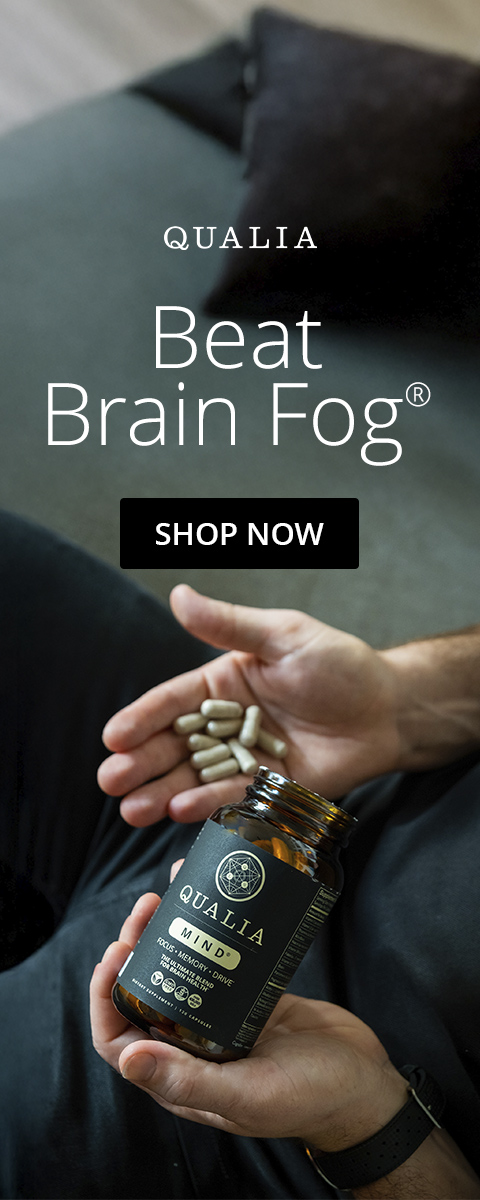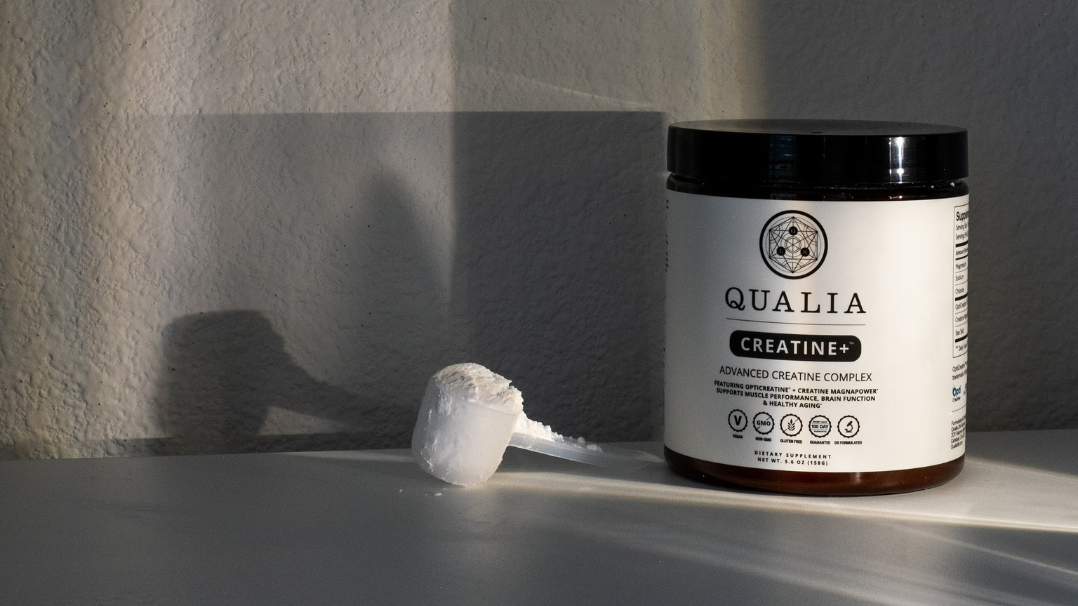What Are Nootropic Mushrooms?
Nootropic mushrooms are mushrooms that have been shown to provide support for brain health and cognition. Mushrooms have been used for centuries in traditional medicine systems for their health-promoting benefits. Their fruiting body (i.e., the stem and cap of the mushroom) and mycelium (i.e., the underground structures) are rich in bioactive compounds, such as β-glucans and other polysaccharides, fatty acids, vitamins, minerals, polyphenols, terpenes, and steroids that can support several aspects of human health, including healthy immune function, antioxidant defenses, metabolism, and brain function [1–3].*
Epidemiological studies have shown that dietary patterns that include mushrooms of any species are associated with healthy cognition and mood [4]. Clinical studies assessing the cognitive benefits of mushrooms are still limited, but animal studies have revealed several species that support different aspects of brain function and health that may contribute to the support of optimal cognitive performance.*
Benefits of Nootropic Mushrooms
Several bioactive compounds found in different mushroom species have shown both direct and indirect benefits for brain health and cognition. Direct effects include support for healthy: 1) immune signaling; 2) antioxidant defenses; 3) neuronal growth factors such as brain-derived neurotrophic factor (BDNF) and nerve growth factor (NGF); and 4) optimal brain cleanup processes and other neuroprotective actions [4–6].*
A more indirect benefit of mushrooms for brain health and cognitive performance includes upholding a healthy gut microbiota and microbial metabolism, which, through the gut-brain axis, can promote healthy neurotransmitter systems and neuronal function, leading to support of cognition [4,7,8]. Many mushroom species are rich in β-glucans, which have prebiotic activity and have been shown to promote the production of short-chain fatty acids (SCFAs) by gut microbes. SCFAs can help modulate neuroimmune and neuroendocrine signaling, which in turn can promote healthy levels and actions of neurotransmitters and hormones involved in cognitive function, mood regulation, and stress responses, for example [4,9–11].*
The Best Nootropic Mushrooms
Here are a few examples of mushrooms that may support brain health. It’s important to highlight that most of these mushrooms have not been studied in human clinical trials for their cognitive benefits yet. They have shown benefits or mechanisms of action in preclinical studies relevant to brain health and function. These mechanisms are consistent with the possibility of nootropic benefits. The only one of these mushrooms that has shown benefits for brain health and function in human studies was Lion’s Mane, which we’re including in the new and improved Qualia Mind.*
Lion’s Mane

Lion’s Mane (Hericium erinaceus) is a culinary mushroom widely consumed in Asian countries such as Japan, Korea, and China, where it also has a long history of use for its health benefits. Lion’s Mane has traditionally been used to naturally support gastrointestinal health, promote healthy digestion, support healthy nervous system function, and promote general vigor and strength [12–14].* Lion’s Mane mushroom stands out for its neuroregenerative potential — it supports neurogenesis and synaptic growth much like botanicals such as Astragalus root, known for supporting stem cell function.
Lion’s Mane mushrooms contain a large variety of bioactive compounds, including hericenones (the main bioactive compounds in the fruiting body), erinacines (the main bioactive compounds in the mycelium), steroids, alkaloids, lactones, polysaccharides (particularly β-glucans and α-glucans), and glycoproteins (particularly glucan-protein complexes) [12,15]. Due to the properties of these bioactive compounds, Lion’s Mane supports healthy antioxidant defenses, healthy immune signaling and balanced immune responses, and optimal protective mechanisms in several tissues and organs, including the gut and the brain [15–24].*
Currently, Lion’s Mane is one of the most popular nootropics because of its reported benefits for nerve and brain health. One of the most interesting effects of Lion’s Mane is its ability to support healthy neuronal and brain structure, as shown mainly in preclinical research. Lion’s Mane has been shown to promote healthy neurogenesis [25–27], the growth of axons and dendrites [28,29], and the production of myelin (a protein that forms a sheath around axons that protects and isolates them and supports nerve impulse conduction) [30,31]. In aged mice, Lion’s Mane helped to maintain healthy brain volume in the cerebellum, a part of the brain that has a key role in motor control, therefore supporting healthy motor function [19].*
These effects may be linked to the support of healthy neurotrophin levels, as these molecules promote the optimal development, growth, survival, and function of neurons. Lion’s Mane has been shown to uphold the activity of two of the main neurotrophins: BDNF and NGF [26,28,29,32–35]. BDNF is particularly relevant for cognitive support because it promotes healthy synaptic plasticity and the mechanisms of learning and memory [36].*
By promoting healthy brain structure and function, Lion’s Mane may potentially contribute to the support of cognitive function. Accordingly, Lion’s Mane has been shown to support memory in healthy animals [29,37] and sustain healthy memory in an animal model of physiological aging [27].*
In human studies, Lion’s Mane administration to older individuals with poor cognitive function helped to maintain BDNF levels, optimal brain structure (specifically white matter), promoted healthy neural organization [32], and supported cognitive function [38].*
Several studies, including one in humans, have shown that Lion’s Mane may promote a healthy gut microbiota composition by supporting the abundance of beneficial microbes, such as Akkermansia muciniphila, Bifidobacterium, and Lactobacillus, and opposing the presence of undesirable microbes [20,21,39–42]. Furthermore, it may support the healthy metabolism of gut microbes, namely the production of SCFAs which support healthy neural, endocrine, and immune signaling [21,43–45]. Through these actions, Lion’s Mane may potentially promote healthy signaling through the gut-brain axis.*
Reishi

Reishi is the common name for Ganoderma lucidum, which is known as the “mushroom of immortality.” It is an edible mushroom that has been used in traditional Asian medicines for thousands of years to support emotional balance, sleep, and clear thinking. Reishi extracts contain several bioactive compounds, most notably, polysaccharides (including β-glucans), peptidoglycans, and triterpenoid compounds (including lucidenic acids) [46–48].*
Modern research on Reishi mushrooms has emphasized its benefits on immune system support and rejuvenation processes. Several preclinical studies have shown that it supports immune cell function and both innate and adaptive immunity [49–63]. Reishi has been shown to support healthy immune function in several clinical trials [64–70]. Its rejuvenating benefits have been evidenced in preclinical research by its effects on supporting antioxidant defenses [71–75], healthy mitochondrial structure and function [76–78], autophagy [76,79], and healthy stem cell proliferation and differentiation [80–82]. Studies have also shown that it supports gut health. Not only has Reishi been shown to support gut immune function, it also supported a healthy gut microbiota composition and microbial metabolism [60,83–89].*
These are all actions that can support optimal brain health. And indeed the benefits of Reishi also extend to the brain. Reishi was shown to support healthy brain mitochondrial function, brain antioxidant defenses, and other neuroprotective functions, including healthy microglial function [76–78,90–94]. It has also been shown to support sleep mechanisms [95–98] and learning and memory in animal models [91,99].*
Cordyceps

Cordyceps is a genus of edible mushrooms that have been used for centuries in traditional medicines in Asia, particularly Tibetan medicine and Traditional Chinese Medicine, for the support of optimal immune function, resistance to fatigue, and supporting energy, among other uses. Cordyceps includes hundreds of species, but the most consumed and studied are C. sinensis and C. militaris. The major bioactive compounds in Cordyceps include nucleosides (namely the adenosine analog cordycepin), polysaccharides, sterols, flavonoids, alkaloids, and polyamines. Cordyceps species have several purported health benefits, including antioxidant and immune supports, support of healthy organ protective functions, support of metabolic function, and combatting fatigue, for example [100].*
The benefits of Cordyceps for brain function and cognition have not yet been studied in humans, but several preclinical studies have shown its potential for brain health support. It has been shown to support healthy neuroprotective functions, brain antioxidant defenses and immune signaling, cerebral blood perfusion, brain mitochondrial function and energy metabolism, and autophagy. These effects have been shown to contribute to the support of healthy cognitive function, particularly memory and learning [101–110].*
Maitake

Maitake is the Japanese name for Grifola frondosa, an edible mushroom that is also known in the US as sheep’s head or hen-of-the-woods. It grows in temperate forests in Asia, Europe, and North America. The major bioactive compounds in Maitake are β-glucans, polysaccharides, glycoproteins, fatty acids, flavonoids, and alkaloids. Through these compounds, maitake provides antioxidant and immune benefits, promotes healthy metabolism, and supports a healthy gut microbiota [111].*
The benefits of Maitake for brain function and cognition have not yet been studied in humans. However, preclinical studies have been promising and have shown neuroprotective effects that help to maintain brain health [112,113]. In animal models, Maitake helped to maintain healthy brain structure, support neural resilience, supported healthy glial cell activity and brain cleanup mechanisms, promoted healthy BDNF levels, and supported learning and memory [113,114]. In aged rats, Maitake supported antioxidant defenses in the brain, maintained healthy brain structure, and promoted healthy memory retention [112].*
Chaga

Chaga (Inonotus obliquus) is a black parasitic mushroom found in the trunk of birch trees in higher latitudes of Europe, Asia, and North America. Although it is a tree disease fungus, it is edible and well tolerated by humans [115]. Chaga has been used for its health benefits for centuries, particularly to support gastrointestinal health, metabolism, and liver health [116].*
Research has shown that Chaga contains several bioactive compounds including polysaccharides, polyphenols, triterpenoids, lignin metabolites, and the sterol inotodiol [117,118]. Through the action of these compounds, Chaga is able to support antioxidant defenses, healthy immune signaling, metabolism, and protective functions in several organs such as the liver and kidneys [115,116].*
Chaga has not yet been studied in humans for nootropic benefits, but based on its known mechanisms, particularly its antioxidant effects, and on a few preclinical studies, it is not unlikely that Chaga may promote healthy brain function. Chaga has been shown to support healthy neuroprotective functions and promote healthy cellular quality control mechanisms in the brain [119–123]. In animal studies, Chaga supported healthy cognitive function [120,122], combated physical fatigue, and showed mechanistic potential to support healthy resistance to mental fatigue [124].*
How to Take Mushroom Nootropics
One of the ways to take nootropic mushrooms is by making them a part of your diet. Mushrooms have been part of the human diet for centuries. There are more than 2000 varieties of edible mushrooms and they are a nutritious and sustainable food choice [125].
Mushrooms are healthy foods: they’re low in calories and high in nutrients; they’re good sources of protein, healthy carbohydrates, dietary fiber, vitamins, and minerals. Also, as we’ve seen, they provide a plethora of bioactive compounds that support health. In addition to the mushrooms we mentioned above, which are all edible, there are other, more common, culinary mushroom species that, despite not yet having been properly studied for brain health support, may also be beneficial given the type of bioactive compounds they provide. These include shiitake (Lentinula edodes), oyster (Pleurotus ostreatus), or even portobello (Agaricus bisporus) mushrooms.*
Another easy way to take nootropic mushrooms is through supplements. Nootropic mushroom supplements may differ in the bioactive compounds they provide depending on whether they are obtained from the fruiting body or the mycelium. For example, Lion’s Mane’s fruiting body is richer in hericenones, while the mycelium provides higher amounts of erinacines, which may have different actions—this means that their benefits may differ. Nevertheless, both the fruiting body and mycelium of Lion’s Mane have been shown to support healthy brain structure and function in preclinical studies.*
Nootropic Mushrooms in Qualia Mind
Lion's Mane benefits for supporting neuroprotective and neurotrophic mechanisms and brain health, particularly healthy brain structure, are the main reason why we’re including Lion’s Mane (as RealLionsMane™) in Qualia Mind 2.0, the upcoming upgrade of Qualia’s flagship nootropic. In addition, Lion’s Mane’s effects on promoting gut health and a healthy gut microbiota may also contribute to the support of healthy brain function through the gut-brain axis. We are using a fruiting body extract—it takes 1 gram of the fruiting body part of the mushroom to make 125 mg—and selected this form (rather than mycelium) based on N=1 experiences reported by biohackers and because this form has shown promising outcomes in clinical research (supported healthy cognitive performance in individuals reporting cognitive issues) [38].*
Feed Your Brain With Qualia Mind
Qualia Mind supports your body’s own ability to upregulate the production of key neurotransmitters, BDNF (Brain-Derived Neurotrophic Factor), and other pathways that are critical for optimal brain function. When you give your brain the fuel it needs to perform its best, magic happens. Learn more about why Qualia Mind is the world’s most advanced cognitive support supplement. Use code mind and take 15% off when you shop Qualia.*
*These statements have not been evaluated by the Food and Drug Administration. This product is not intended to diagnose, treat, cure, or prevent any disease.
References:
[1] O. Rop, J. Mlcek, T. Jurikova, Nutr. Rev. 67 (2009) 624–631.
[2] P. Roupas, J. Keogh, M. Noakes, C. Margetts, P. Taylor, J. Funct. Foods 4 (2012) 687–709.
[3] C.-W. Phan, P. David, V. Sabaratnam, J. Med. Food 20 (2017) 1–10.
[4] S. Cha, L. Bell, B. Shukitt-Hale, C.M. Williams, Neurosci. Biobehav. Rev. 158 (2024) 105548.
[5] C.-W. Phan, P. David, M. Naidu, K.-H. Wong, V. Sabaratnam, Crit. Rev. Biotechnol. 35 (2015) 355–368.
[6] G. Anusiya, U. Gowthama Prabu, N.V. Yamini, N. Sivarajasekar, K. Rambabu, G. Bharath, F. Banat, Bioengineered 12 (2021) 11239–11268.
[7] W. Xiao, Q. Zhang, L. Yu, F. Tian, W. Chen, Q. Zhai, Food Science and Human Wellness 11 (2022) 208–217.
[8] L.G. Canipe 3rd, M. Sioda, C.L. Cheatham, Arch. Gerontol. Geriatr. 96 (2021) 104464.
[9] M.E. Valverde, T. Hernández-Pérez, O. Paredes-López, Int. J. Microbiol. 2015 (2015) 376387.
[10] M. Li, L. Yu, J. Zhao, H. Zhang, W. Chen, Q. Zhai, F. Tian, J. Funct. Foods 83 (2021) 104538.
[11] C. Cerletti, S. Esposito, L. Iacoviello, Nutrients 13 (2021).
[12] A.G. Gravina, R. Pellegrino, S. Auletta, G. Palladino, G. Brandimarte, R. D’Onofrio, G. Arboretto, G. Imperio, A. Ventura, M. Cipullo, M. Romano, A. Federico, World J. Gastroenterol. 29 (2023) 3048–3065.
[13] B. Thongbai, S. Rapior, K.D. Hyde, K. Wittstein, M. Stadler, Mycol. Prog. 14 (2015) 91.
[14] K. Spelman, E. Sutherland, A. Bagade, J. Restor. Med. 6 (2017) 19–26.
[15] M. Friedman, J. Agric. Food Chem. 63 (2015) 7108–7123.
[16] X.-Y. Wang, J.-Y. Yin, M.-M. Zhao, S.-Y. Liu, S.-P. Nie, M.-Y. Xie, Carbohydr. Polym. 186 (2018) 100–109.
[17] B. Tian, P. Wang, T. Xu, M. Cai, R. Mao, L. Huang, P. Sun, K. Yang, Food Funct. 14 (2023) 2921–2932.
[18] H. Li, H. Zhao, W. Liu, Y. Feng, Y. Zhang, F. Yuan, L. Jia, Int. J. Med. Mushrooms 23 (2021) 55–65.
[19] E. Roda, E.C. Priori, D. Ratto, F. De Luca, C. Di Iorio, P. Angelone, C.A. Locatelli, A. Desiderio, L. Goppa, E. Savino, M.G. Bottone, P. Rossi, Int. J. Mol. Sci. 22 (2021).
[20] Y. Ren, Q. Sun, R. Gao, Y. Sheng, T. Guan, W. Li, L. Zhou, C. Liu, H. Li, Z. Lu, L. Yu, J. Shi, Z. Xu, Y. Xue, Y. Geng, Nutrients 15 (2023).
[21] B. Tian, R. Liu, T. Xu, M. Cai, R. Mao, L. Huang, K. Yang, X. Zeng, S. Peilong, J. Sci. Food Agric. 103 (2023) 3050–3064.
[22] J. Zhang, S. An, W. Hu, M. Teng, X. Wang, Y. Qu, Y. Liu, Y. Yuan, D. Wang, Int. J. Mol. Sci. 17 (2016).
[23] N. Kushairi, C.W. Phan, V. Sabaratnam, P. David, M. Naidu, Antioxidants (Basel) 8 (2019).
[24] S.C. Chau, P.S. Chong, H. Jin, K.C. Tsui, S. Khairuddin, A.C.K. Tse, S.Y. Lew, G.L. Tipoe, C.W. Lee, M.-L. Fung, K.H. Wong, L.W. Lim, Int. J. Mol. Sci. 24 (2023).
[25] S. Ryu, H.G. Kim, J.Y. Kim, S.Y. Kim, K.-O. Cho, J. Med. Food 21 (2018) 174–180.
[26] T. Tsai-Teng, C. Chin-Chu, L. Li-Ya, C. Wan-Ping, L. Chung-Kuang, S. Chien-Chang, H.F. Chi-Ying, C. Chien-Chih, Y.-J. Shiao, J. Biomed. Sci. 23 (2016) 49.
[27] D. Ratto, F. Corana, B. Mannucci, E.C. Priori, F. Cobelli, E. Roda, B. Ferrari, A. Occhinegro, C. Di Iorio, F. De Luca, V. Cesaroni, C. Girometta, M.G. Bottone, E. Savino, H. Kawagishi, P. Rossi, Nutrients 11 (2019).
[28] P.-L. Lai, M. Naidu, V. Sabaratnam, K.-H. Wong, R.P. David, U.R. Kuppusamy, N. Abdullah, S.N.A. Malek, Int. J. Med. Mushrooms 15 (2013) 539–554.
[29] R. Martínez-Mármol, Y. Chai, J.N. Conroy, Z. Khan, S.-M. Hong, S.B. Kim, R.S. Gormal, D.H. Lee, J.K. Lee, E.J. Coulson, M.K. Lee, S.Y. Kim, F.A. Meunier, J. Neurochem. 165 (2023) 791–808.
[30]H.-T. Huang, C.-H. Ho, H.-Y. Sung, L.-Y. Lee, W.-P. Chen, Y.-W. Chen, C.-C. Chen, C.-S. Yang, S.-F. Tzeng, Sci. Rep. 11 (2021) 6551.
[31]E.V. Kolotushkina, M.G. Moldavan, K.Y. Voronin, G.G. Skibo, Fiziol. Zh. 49 (2003) 38–45.
[32]I.-C. Li, H.-H. Chang, C.-H. Lin, W.-P. Chen, T.-H. Lu, L.-Y. Lee, Y.-W. Chen, Y.-P. Chen, C.-C. Chen, D.P.-C. Lin, Front. Aging Neurosci. 12 (2020) 155.
[33]R. Martínez-Mármol, Y. Chai, Z. Khan, S.B. Kim, S.M. Hong, R.S. Gormal, D.H. Lee, J.K. Lee, M.K. Lee, S.Y. Kim, F.A. Meunier, bioRxiv (2020) 2020.08.28.271676.
[34]L. Vigna, F. Morelli, G.M. Agnelli, F. Napolitano, D. Ratto, A. Occhinegro, C. Di Iorio, E. Savino, C. Girometta, F. Brandalise, P. Rossi, Evid. Based. Complement. Alternat. Med. 2019 (2019) 7861297.
[35]K. Mori, Y. Obara, M. Hirota, Y. Azumi, S. Kinugasa, S. Inatomi, N. Nakahata, Biol. Pharm. Bull. 31 (2008) 1727–1732.
[36]B. Lu, G. Nagappan, Y. Lu, Handb. Exp. Pharmacol. 220 (2014) 223–250.
[37]P. Rossi, V. Cesaroni, F. Brandalise, A. Occhinegro, D. Ratto, F. Perrucci, V. Lanaia, C. Girometta, G. Orrù, E. Savino, Int. J. Med. Mushrooms 20 (2018) 485–494.
[38]K. Mori, S. Inatomi, K. Ouchi, Y. Azumi, T. Tuchida, Phytother. Res. 23 (2009) 367–372.
[39]X.-Q. Xie, Y. Geng, Q. Guan, Y. Ren, L. Guo, Q. Lv, Z.-M. Lu, J.-S. Shi, Z.-H. Xu, Nutrients 13 (2021).
[40]B. Tian, Y. Geng, T. Xu, X. Zou, R. Mao, X. Pi, W. Wu, L. Huang, K. Yang, X. Zeng, P. Sun, Front Nutr 9 (2022) 858585.
[41]W. Cui, X. Song, X. Li, L. Jia, C. Zhang, Int. J. Biol. Macromol. 242 (2023) 125165.
[42]Y. Yang, H. Ye, C. Zhao, L. Ren, C. Wang, M.I. Georgiev, J. Xiao, T. Zhang, Carbohydr. Polym. 262 (2021) 117668.
[43]E.K. Mitsou, G. Saxami, E. Stamoulou, E. Kerezoudi, E. Terzi, G. Koutrotsios, G. Bekiaris, G.I. Zervakis, K.C. Mountzouris, V. Pletsa, A. Kyriacou, Molecules 25 (2020).
[44]Y. Yang, C. Zhao, M. Diao, S. Zhong, M. Sun, B. Sun, H. Ye, T. Zhang, Molecules 23 (2018).
[45]Z.Y. Kho, S.K. Lal, Front. Microbiol. 9 (2018) 1835.
[46]S. Wachtel-Galor, J. Yuen, J.A. Buswell, I.F.F. Benzie, in: I.F.F. Benzie, S. Wachtel-Galor (Eds.), Herbal Medicine: Biomolecular and Clinical Aspects, CRC Press/Taylor & Francis, Boca Raton (FL), 2012.
[47]J.L. Gao, K.S.Y. Leung, Y.T. Wang, C.M. Lai, S.P. Li, L.F. Hu, G.H. Lu, Z.H. Jiang, Z.L. Yu, J. Pharm. Biomed. Anal. 44 (2007) 807–811.
[48]S.-Y. Lin, Y.-K. Chen, H.-T. Yu, G.S. Barseghyan, M.D. Asatiani, S.P. Wasser, J.-L. Mau, Int. J. Med. Mushrooms 15 (2013) 315–323.
[49]Y. Gao, H. Gao, E. Chan, W. Tang, A. Xu, H. Yang, M. Huang, J. Lan, X. Li, W. Duan, C. Xu, S. Zhou, Immunol. Invest. 34 (2005) 171–198.
[50]X.-L. Zhu, A.-F. Chen, Z.-B. Lin, J. Ethnopharmacol. 111 (2007) 219–226.
[51]Y.-H. Chang, J.-S. Yang, J.-L. Yang, C.-L. Wu, S.-J. Chang, K.-W. Lu, C.-L. Kuo, T.-C. Hsia, J.-G. Chung, In Vivo 23 (2009) 755–759.
[52]C.-Y. Lai, J.-T. Hung, H.-H. Lin, A.L. Yu, S.-H. Chen, Y.-C. Tsai, L.-E. Shao, W.-B. Yang, J. Yu, Vaccine 28 (2010) 4945–4954.
[53]S.-Q. Huang, Z.-X. Ning, Int. J. Biol. Macromol. 47 (2010) 336–341.
[54]Y.-S. Wu, S.-Y. Ho, F.-H. Nan, S.-N. Chen, BMC Complement. Altern. Med. 16 (2016) 500.
[55]C. Wang, S. Shi, Q. Chen, S. Lin, R. Wang, S. Wang, C. Chen, Integr. Cancer Ther. 17 (2018) 674–683.
[56]Q. Huang, L. Li, H. Chen, Q. Liu, Z. Wang, Nutrients 11 (2019).
[57]N.S. Lai, R.H. Lin, R.S. Lai, U.C. Kun, S.C. Leu, Lupus 10 (2001) 461–465.
[58]C.-C. Pi, C.-L. Chu, C.-Y. Lu, Y.-J. Zhuang, C.-L. Wang, Y.-H. Yu, H.-Y. Wang, C.-C. Lin, C.-J. Chen, Vaccine 32 (2014) 401–408.
[59]A. Kubota, M. Kobayashi, S. Sarashina, R. Takeno, K. Okamoto, K. Narumi, A. Furugen, Y. Suzuki, N. Takahashi, K. Iseki, J. Ethnopharmacol. 214 (2018) 240–243.
[60]Y. Yang, D.E. Nirmagustina, T. Kumrungsee, Y. Okazaki, H. Tomotake, N. Kato, Biosci. Biotechnol. Biochem. 81 (2017) 1796–1804.
[61]L.-H. Chen, Z.-B. Lin, W.-D. Li, Acta Pharmacol. Sin. 32 (2011) 1505–1512.
[62]J. Meng, X. Hu, F. Shan, H. Hua, C. Lu, E. Wang, Z. Liang, Int. J. Biol. Macromol. 49 (2011) 693–699.
[63]Y.-L. Lin, S.-S. Lee, S.-M. Hou, B.-L. Chiang, Mol. Pharmacol. 70 (2006) 637–644.
[64]Y. Hijikata, A. Yasuhara, Y. Sahashi, Am. J. Chin. Med. 33 (2005) 517–523.
[65]Y. Gao, W. Tang, X. Dai, H. Gao, G. Chen, J. Ye, E. Chan, H.L. Koh, X. Li, S. Zhou, J. Med. Food 8 (2005) 159–168.
[66]Y. Hijikata, S. Yamada, A. Yasuhara, J. Altern. Complement. Med. 13 (2007) 985–987.
[67]B. Donatini, Int. J. Med. Mushrooms 16 (2014) 497–498.
[68]Y. Gao, S. Zhou, W. Jiang, M. Huang, X. Dai, Immunol. Invest. 32 (2003) 201–215.
[69]X. Chen, Z.-P. Hu, X.-X. Yang, M. Huang, Y. Gao, W. Tang, S.Y. Chan, X. Dai, J. Ye, P.C.-L. Ho, W. Duan, H.-Y. Yang, Y.-Z. Zhu, S.-F. Zhou, Int. Immunopharmacol. 6 (2006) 499–508.
[70]Y. Zhang, Z. Lin, Y. Hu, F. Wang, British Journal of Sports Medicine 42 (2008) 519–522.
[71]H.N. Li, L.L. Zhao, D.Y. Zhou, D.Q. Chen, Med. Sci. Monit. 26 (2020) e921905.
[72]F. Xu, X. Li, X. Xiao, L.-F. Liu, L. Zhang, P.-P. Lin, S.-L. Zhang, Q.-S. Li, Biomed. Pharmacother. 95 (2017) 504–512.
[73]Y.-H. Lee, J.-H. Kim, C.-H. Song, K.-J. Jang, C.-H. Kim, J.-S. Kang, Y.-H. Choi, H.-M. Yoon, J Pharmacopuncture 19 (2016) 59–69.
[74]T.-C. Hsieh, J.M. Wu, Int. J. Mol. Med. 28 (2011) 1065–1069.
[75]D. Sargowo, N. Ovianti, E. Susilowati, N. Ubaidillah, A.W. Nugraha, Vitriyaturrida, K.S. Proboretno, M. Failasufi, F. Ramadhan, H. Wulandari, Y. Waranugraha, D.H. Putri, Indian Heart Journal 70 (2018) 608–614.
[76] Z.-L. Ren, C.-D. Wang, T. Wang, H. Ding, M. Zhou, N. Yang, Y.-Y. Liu, P. Chan, Acta Pharmacol. Sin. 40 (2019) 441–450.
[77] T.A. Ajith, N.P. Sudheesh, D. Roshny, G. Abishek, K.K. Janardhanan, Exp. Gerontol. 44 (2009) 219–223.
[78] L.-W. Chen, L.-Y. Horng, C.-L. Wu, H.-C. Sung, R.-T. Wu, Neuropharmacology 63 (2012) 719–732.
[79] K. Hou, Q. Yu, X. Hu, X. Ding, J. Hong, Y. Chen, J. Xie, S. Nie, M. Xie, Food Chem. Toxicol. 133 (2019) 110757.
[80] W.-Y. Chen, W.-B. Yang, C.-H. Wong, D.T.-B. Shih, Bioorg. Med. Chem. 18 (2010) 8583–8591.
[81] Y.-M. Yan, X.-L. Wang, Q. Luo, L.-P. Jiang, C.-P. Yang, B. Hou, Z.-L. Zuo, Y.-B. Chen, Y.-X. Cheng, Phytochemistry 114 (2015) 155–162.
[82] Y. Pan, A. Zhao, Z. Zhong, X. Pan, S. Cai, Biotechnol. Prog. 35 (2019) e2869.
[83] M. Chen, D. Xiao, W. Liu, Y. Song, B. Zou, L. Li, P. Li, Y. Cai, D. Liu, Q. Liao, Z. Xie, Int. J. Biol. Macromol. (2019).
[84] J. Xie, Y. Liu, B. Chen, G. Zhang, S. Ou, J. Luo, X. Peng, Food Nutr. Res. 63 (2019).
[85] J. Su, D. Li, Q. Chen, M. Li, L. Su, T. Luo, D. Liang, G. Lai, O. Shuai, C. Jiao, Q. Wu, Y. Xie, X. Zhou, Front. Microbiol. 9 (2018) 3099.
[86] J. Su, L. Su, D. Li, O. Shuai, Y. Zhang, H. Liang, C. Jiao, Z. Xu, Y. Lai, Y. Xie, Front. Immunol. 9 (2018) 1765.
[87] W.-L. Guo, Y.-Y. Pan, L. Li, T.-T. Li, B. Liu, X.-C. Lv, Food Funct. 9 (2018) 3419–3431.
[88] L.-F. Li, H.-B. Liu, Q.-W. Zhang, Z.-P. Li, T.-L. Wong, H.-Y. Fung, J.-X. Zhang, S.-P. Bai, A.-P. Lu, Q.-B. Han, Sci. Rep. 8 (2018) 6172.
[89] M. Jin, Y. Zhu, D. Shao, K. Zhao, C. Xu, Q. Li, H. Yang, Q. Huang, J. Shi, Int. J. Biol. Macromol. 94 (2017) 1–9.
[90] N.P. Sudheesh, T.A. Ajith, V. Ramnath, K.K. Janardhanan, Clin. Nutr. 29 (2010) 406–412.
[91] Y. Zhou, Z.-Q. Qu, Y.-S. Zeng, Y.-K. Lin, Y. Li, P. Chung, R. Wong, U. Hägg, Exp. Toxicol. Pathol. 64 (2012) 673–680.
[92] C. Qin, S.-Q. Wu, B.-S. Chen, X.-X. Wu, K.-Y. Qu, J.-M. Liu, G.-F. Zhang, Y.-F. Xu, S. Shu, L. Sun, Y.-Y. Li, H. Zhu, L. Huang, C.-M. Ma, Y.-H. Xu, Y.-L. Han, Y.-Z. Lu, Zhongguo Yi Xue Ke Xue Yuan Xue Bao 39 (2017) 552–561.
[93] Q. Cai, Y. Li, G. Pei, J. Neuroinflammation 14 (2017) 63.
[94] R. Zhang, S. Xu, Y. Cai, M. Zhou, X. Zuo, P. Chan, Evid. Based. Complement. Alternat. Med. 2011 (2011) 156810.
[95] Honda K., Komoda Y., Inoué S., Tokyo Ika. Shika. Daigaku Iyo Kizai Kenkyusho. Hokoku 22 (1988) 77–82.
[96] L. Yu, H. Wei, International Journal of Medicinal Mushrooms 2 (2000) 6.
[97] Q.-P. Chu, L.-E. Wang, X.-Y. Cui, H.-Z. Fu, Z.-B. Lin, S.-Q. Lin, Y.-H. Zhang, Pharmacol. Biochem. Behav. 86 (2007) 693–698.
[98] X.-Y. Cui, S.-Y. Cui, J. Zhang, Z.-J. Wang, B. Yu, Z.-F. Sheng, X.-Q. Zhang, Y.-H. Zhang, J. Ethnopharmacol. 139 (2012) 796–800.
[99] S. Huang, J. Mao, K. Ding, Y. Zhou, X. Zeng, W. Yang, P. Wang, C. Zhao, J. Yao, P. Xia, G. Pei, Stem Cell Reports 8 (2017) 84–94.
[100] G. Das, H.-S. Shin, G. Leyva-Gómez, M.L.D. Prado-Audelo, H. Cortes, Y.D. Singh, M.K. Panda, A.P. Mishra, M. Nigam, S. Saklani, P.K. Chaturi, M. Martorell, N. Cruz-Martins, V. Sharma, N. Garg, R. Sharma, J.K. Patra, Front. Pharmacol. 11 (2020) 602364.
[101] P. Wei, K. Wang, C. Luo, Y. Huang, D. Misilimu, H. Wen, P. Jin, C. Li, Y. Gong, Y. Gao, J. Neuroinflammation 18 (2021) 137.
[102] Y. Li, L. He, H. Song, X. Bao, S. Niu, J. Bai, J. Ma, R. Yuan, S. Liu, J. Guo, J. Ethnopharmacol. 332 (2024) 118321.
[103]R.K. Veena, E.J. Carmel, H. Ramya, T.A. Ajith, S.P. Wasser, K.K. Janardhanan, Int. J. Med. Mushrooms 22 (2020) 593–604.
[104]Z. Li, Z. Zhang, J. Zhang, J. Jia, J. Ding, R. Luo, Z. Liu, J. Med. Food 15 (2012) 1057–1063.
[105]S.-H. Lee, I.-G. Ko, S.-E. Kim, L. Hwang, J.-J. Jin, H.-H. Choi, C.-J. Kim, J Exerc Rehabil 12 (2016) 69–78.
[106]N. Soraksa, N. Heebkaew, W. Promjantuek, P. Kunhorm, P. Kaokean, N. Chaicharoenaudomung, P. Noisa, J. Asian Nat. Prod. Res. 26 (2024) 583–603.
[107]X. Bai, T.-Y. Tan, Y.-X. Li, Y. Li, Y.-F. Chen, R. Ma, S.-Y. Wang, Q. Li, Z.-Q. Liu, Biomed. Pharmacother. 124 (2020) 109834.
[108]G. Yuan, L. An, Y. Sun, G. Xu, P. Du, Evid. Based. Complement. Alternat. Med. 2018 (2018) 9419264.
[109]Y.O. Kim, H.J. Kim, G.M. Abu-Taweel, J. Oh, G.-H. Sung, Saudi J. Biol. Sci. 26 (2019) 1352–1357.
[110]C.-Y. Chang, P.-X. Yang, T.-L. Yu, C.-L. Lee, Nutrients 15 (2023).
[111]J.-Y. Wu, K.-C. Siu, P. Geng, Foods 10 (2021).
[112]Z. Chen, Y. Tang, A. Liu, X. Jin, J. Zhu, X. Lu, Mol. Nutr. Food Res. 61 (2017).
[113]Y. Bai, L. Chen, Y. Chen, X. Chen, Y. Dong, S. Zheng, L. Zhang, W. Li, J. Du, H. Li, RSC Adv. 9 (2019) 37127–37135.
[114]L. Fan, L. Chen, Z. Liang, H. Bao, D. Wang, Y. Dong, S. Zheng, C. Xiao, J. Du, H. Li, Int. J. Med. Mushrooms 21 (2019) 1065–1074.
[115]M.Y. Shashkina, P.N. Shashkin, A.V. Sergeev, Pharm. Chem. J. 40 (2006) 560–568.
[116]P.T.Y. Ern, T.Y. Quan, F.S. Yee, A.C.Y. Yin, Mycology 15 (2024) 144–161.
[117]K.C. Duru, E.G. Kovaleva, I.G. Danilova, P. van der Bijl, Phytother. Res. 33 (2019) 1966–1980.
[118]C. Liu, C. Zhao, H.-H. Pan, J. Kang, X.-T. Yu, H.-Q. Wang, B.-M. Li, Y.-Z. Xie, R.-Y. Chen, J. Nat. Prod. 77 (2014) 35–41.
[119]S. Wang, K. Dong, J. Zhang, C. Chen, H. Shuai, X. Yu, Nutr. Res. Pract. 17 (2023) 1128–1142.
[120]Y. Han, S. Nan, J. Fan, Q. Chen, Y. Zhang, Int. J. Biol. Macromol. 131 (2019) 769–778.
[121]Y. Xin, Y. Zhang, X. Zhang, Int. J. Med. Mushrooms 23 (2021) 55–62.
[122]V.V. Giridharan, R.A. Thandavarayan, T. Konishi, Food Funct. 2 (2011) 320–327.
[123]J.H. Jeong, S.H. Kim, M.N. Park, J.Y. Park, H.Y. Park, C.E. Song, J.H. Moon, A.L. Choi, K.D. Kim, N.S. Lee, Y.G. Jeong, D.K. Kim, B.H. Lee, Y.C. Yoo, S.Y. Han, Curr. Issues Mol. Biol. 43 (2021) 365–383.
[124]C.-J. Zhang, J.-Y. Guo, H. Cheng, L. Li, Y. Liu, Y. Shi, J. Xu, H.-T. Yu, Int. J. Biol. Macromol. 151 (2020) 855–860.
[125]M. Jo Feeney, A.M. Miller, P. Roupas, Nutr. Today 49 (2014) 301–307.








No Comments Yet
Sign in or Register to Comment